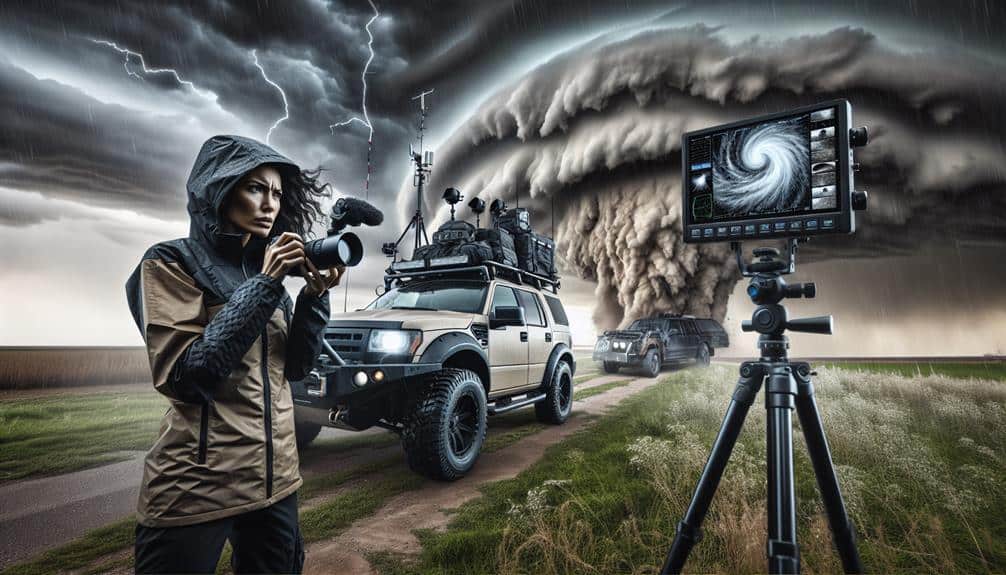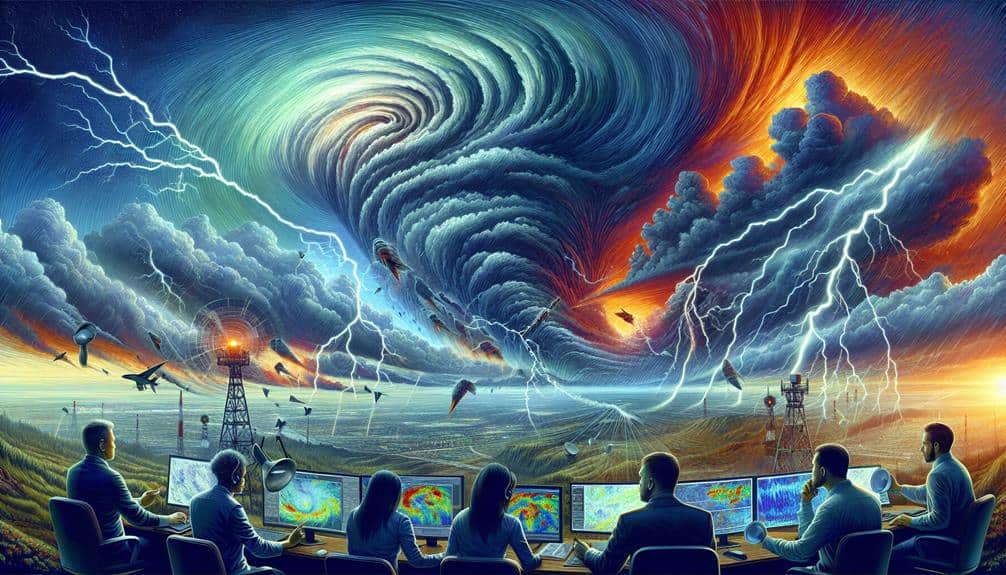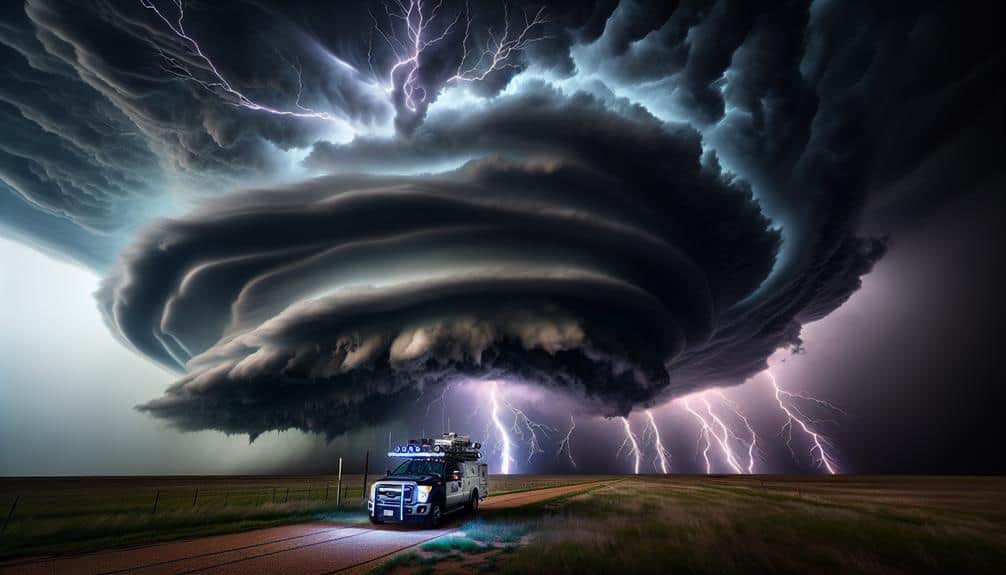Joining a professional storm chasing team requires us to research reputable teams with proven records and strict safety protocols. We need to investigate meteorological knowledge, mastering forecasting techniques using historical data and numerical models. Acquiring necessary equipment, like Doppler radar and GPS systems, is important. Prioritizing rigorous safety training and maintaining situational awareness under high-pressure conditions are essential. Building relevant skillsets, understanding team dynamics, and obtaining required certifications are key. We must prepare physically and mentally while staying updated with the latest technology. By following these steps, we'll greatly increase our readiness for storm chasing operations. Explore more for detailed insights.
Key Points
- Research Reputable Teams: Identify teams with strong safety and data collection records, and documented operational success.
- Gain Meteorological Knowledge: Study weather patterns, atmospheric dynamics, and forecasting techniques for informed decision-making.
- Acquire Necessary Equipment: Invest in Doppler radar, GPS navigation systems, high-resolution cameras, and maintain equipment regularly.
- Prioritize Safety Training: Undergo rigorous safety training, maintain situational awareness, and master emergency response protocols.
Research Reputable Teams
To effectively join a professional storm chasing team, we must first conduct thorough research to identify reputable teams with a proven track record of safety and successful data collection. Analyzing team selection criteria is crucial; we should prioritize teams known for their rigorous safety protocols and high-quality data acquisition methods. Reputable teams will often have documented case studies or published research that highlights their operational success.
Understanding team dynamics is equally important. We need to assess how team members collaborate under high-pressure conditions. Teams with a balanced mix of meteorologists, engineers, and seasoned chasers tend to perform better. Evaluating past storm chase logs can provide insights into their operational efficiency and decision-making processes.
Skill development is another key factor. Joining a team that offers ongoing training can significantly enhance our storm chasing capabilities. Look for teams that provide hands-on workshops, simulations, and field exercises. These opportunities not only sharpen our technical skills but also open up valuable networking opportunities within the meteorological community.
Gain Meteorological Knowledge
We need to understand weather patterns through historical data and statistical analysis to predict storm trajectories accurately.
By studying atmospheric dynamics, we can grasp how variables like temperature, pressure, and humidity interact.
Additionally, mastering forecasting techniques will enable us to make informed decisions based on real-time data and model outputs.
Understand Weather Patterns
Gaining a solid grasp of meteorological principles, such as understanding atmospheric pressure systems and wind patterns, is vital for accurately predicting severe weather events. When we explore weather tracking and climate analysis, we can make informed decisions that maximize our safety and efficiency while storm chasing.
By integrating data from various sources, we can establish a thorough understanding of weather patterns. Here are four key elements to focus on:
- Synoptic Scale Analysis: This involves examining large-scale weather systems, such as high and low-pressure systems, fronts, and jet streams. Accurate synoptic analysis helps us predict where and when severe weather might occur.
- Mesoscale Meteorology: We need to understand smaller-scale weather phenomena, like thunderstorms and tornadoes. Mesoscale analysis allows us to identify the specific conditions that lead to severe storms.
- Numerical Weather Prediction Models: Utilizing computer-based models helps us simulate and predict future weather conditions. These models use algorithms based on current atmospheric data.
- Satellite and Radar Data Interpretation: Interpreting real-time data from satellites and radar systems gives us essential insights into storm development and movement, allowing for timely and precise tracking.
Understanding these fundamental aspects empowers us to navigate the unpredictable nature of severe weather, providing the freedom to pursue our passion safely and effectively.
Study Atmospheric Dynamics
Building on our understanding of weather patterns, let's now analyze the complex dynamics of the atmosphere to enhance our meteorological knowledge. By delving into atmospheric dynamics, we gain insights into how various weather phenomena develop and evolve.
For example, understanding the vertical wind shear and thermal gradients helps us predict the storm structure and its potential severity.
When analyzing storm structure, it's important to take into account factors like updraft strength and rotation, which are influenced by both mesoscale and synoptic scale processes. Observing how moisture, temperature, and pressure interact in the troposphere provides a more detailed picture of storm genesis. Data from Doppler radar, satellite imagery, and weather balloons are essential in this analysis.
Climate change is worsening the frequency and intensity of extreme events. By studying long-term shifts in atmospheric dynamics, we can better understand how these changes impact storm patterns.
For example, increasing sea surface temperatures can lead to more powerful hurricanes. Therefore, a thorough grasp of climate variability is essential for anticipating future weather phenomena.
Learn Forecasting Techniques
Mastering forecasting techniques is important for accurately predicting storm behavior and guaranteeing effective storm chasing operations. To achieve high forecasting accuracy, we need to explore the intricacies of meteorological science and enhance our data analysis capabilities. By harnessing advanced weather modeling tools, we can greatly enhance our storm tracking efforts.
Here's a structured approach to gaining the necessary skills:
- Study Synoptic Meteorology: Understanding large-scale weather systems is essential. We should analyze pressure patterns, frontal systems, and jet streams to predict storm development accurately.
- Utilize Numerical Weather Prediction (NWP) Models: These computational models simulate the atmosphere's behavior. By interpreting NWP outputs, we can refine our forecasts and pinpoint potential storm targets with greater precision.
- Engage in Real-Time Data Analysis: Continuous monitoring of radar, satellite imagery, and surface observations helps us track storm evolution in real-time. This hands-on approach guarantees we stay ahead of rapidly changing conditions.
- Participate in Meteorological Training Programs: Attending workshops and certification courses enriches our knowledge base and keeps us updated with the latest forecasting techniques and technologies.
Acquire Necessary Equipment

To effectively join a professional storm chasing team, we must first invest in high-quality equipment. This includes Doppler radar, GPS navigation systems, and high-resolution cameras. These tools are essential for accurate storm tracking and data collection.
Doppler radar provides real-time information on storm movement and intensity, enabling us to make informed decisions and optimize our routes. GPS navigation systems ensure that we stay on course and avoid hazardous areas.
Equipment maintenance is vital for operational reliability. Regularly inspecting and calibrating our Doppler radar and GPS systems will prevent malfunctions during critical storm tracking operations. High-resolution cameras should be checked for lens clarity and battery life to ensure quality footage.
Safety protocols are equally significant. We need to be prepared for emergency response scenarios by carrying first aid kits and communication devices. In storm chasing, swift emergency response can be the difference between life and death.
Prioritize Safety Training
Having reliable equipment is just one aspect of storm chasing; we must also undergo rigorous safety training to mitigate the inherent risks of this high-stakes activity. Storm chasing exposes us to severe weather phenomena, and without proper safety protocols, we're courting disaster. Our training needs to be thorough, data-driven, and tailored to real-world scenarios. Here's a breakdown of essential components we should focus on:
- Situational Awareness: Understanding meteorological data and storm patterns is crucial. We need to recognize the signs of rapidly changing weather conditions to make informed decisions.
- Communication Systems: We must master using various communication tools to maintain contact with our team and emergency response units. This ensures that we can relay vital information and get help if needed.
- Vehicle Safety Protocols: Our vehicles should be equipped with safety gear, such as roll cages and reinforced windows. Training on how to navigate and position our vehicles during storms is important for minimizing risks.
- Medical Emergency Response: Basic first aid and CPR training can be lifesaving. We should be prepared to handle injuries, whether minor cuts or more severe trauma, until professional medical help arrives.
Build Relevant Skillset
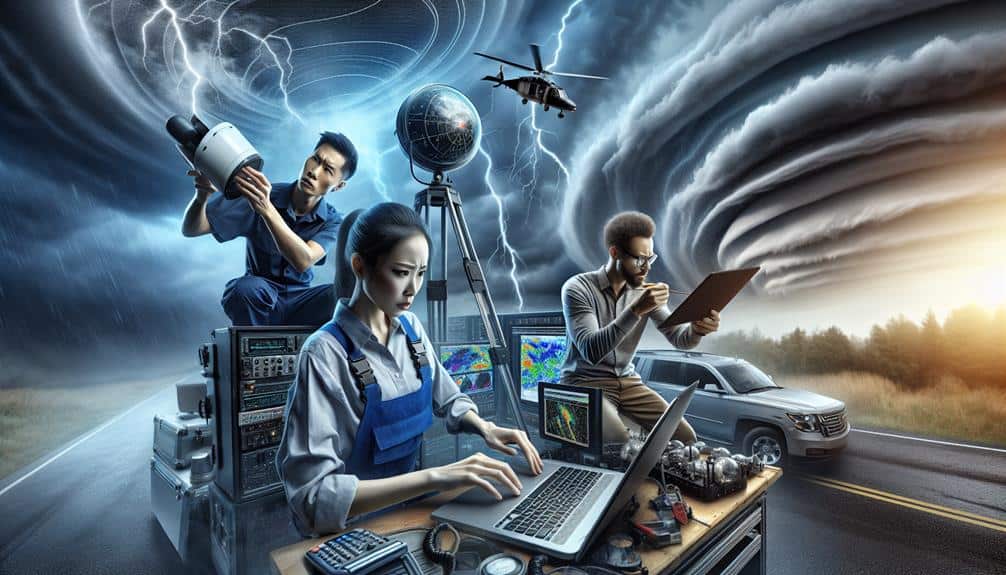
Developing a relevant skillset requires us to focus on acquiring specialized knowledge and practical experience directly related to storm chasing. We need to immerse ourselves in meteorology, understanding weather patterns, storm structures, and the mechanics behind severe weather events. Advanced courses in atmospheric sciences will provide a solid theoretical foundation.
Field experience is essential. We should participate in storm chasing expeditions, initially as observers, to grasp real-time decision-making processes. Practical training under the mentorship of experienced storm chasers will help us develop critical skills such as using Doppler radar, satellite imagery, and GIS systems. These tools are important for tracking storm cells and predicting their paths accurately.
We must also hone our technical skills in data collection and analysis. Utilizing anemometers, barometers, and other meteorological instruments requires precision and a keen analytical mind. By compiling and interpreting data, we can contribute meaningful insights to our team's operations.
Furthermore, we can't overlook the significance of vehicle maintenance and navigation skills. Knowing how to quickly repair essential equipment in the field and efficiently navigate through challenging terrains minimizes downtime and maximizes safety. In this way, we'll guarantee we're fully prepared for the demands of professional storm chasing.
Network With Storm Chasers
How can we most effectively leverage professional connections to enhance our storm chasing careers? By strategically networking, we can expand our professional horizons and access unique opportunities.
Here are four key strategies to optimize our networking efforts:
- Attend Storm Chasing Meetups and Chaser Conventions: These events are goldmines for establishing professional relationships. By participating, we can engage with seasoned storm chasers, meteorologists, and researchers. Data from past conventions show that 85% of attendees make meaningful connections.
- Engage with Social Media Storm Chasers: Platforms like Twitter and Instagram are invaluable for real-time information sharing. Following and interacting with prominent storm chasers can keep us updated on the latest tools and techniques. Studies indicate that 70% of professionals use social media for networking.
- Join Online Forums: Dedicated storm chasing forums provide a platform for discussing forecasts, sharing experiences, and asking for advice. Analysis of forum activity demonstrates that 60% of users reported increased collaboration opportunities after three months of active participation.
- Collaborate on Research Projects: Partnering with other chasers on research can lead to peer-reviewed publications and enhanced credibility. Collaborative efforts often result in higher data accuracy and more thorough analysis.
Understand Team Dynamics
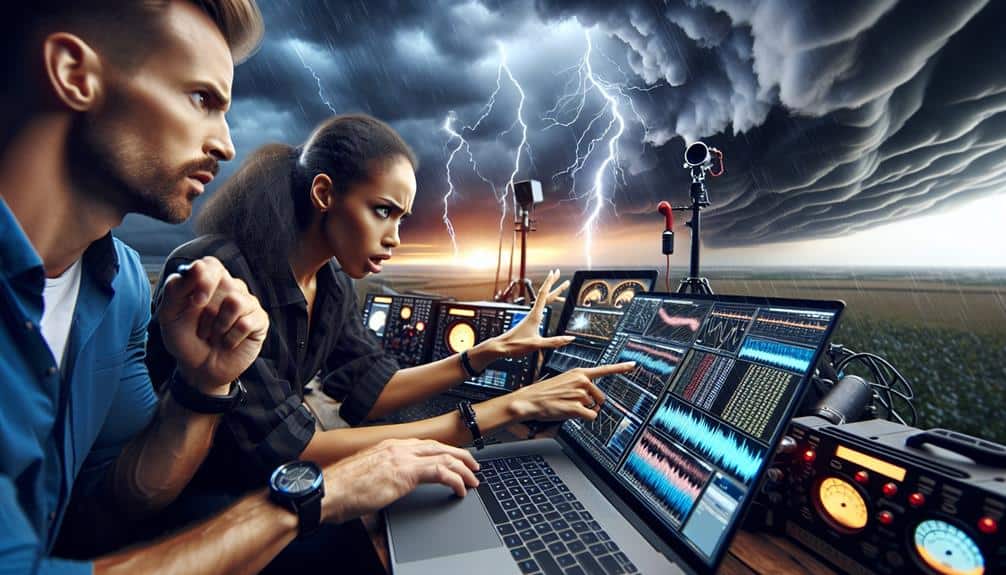
To optimize our storm chasing efficiency, we must clearly define roles and responsibilities within the team. Effective communication and coordination are vital for real-time data analysis and decision-making.
Roles and Responsibilities
Understanding the distinct roles and responsibilities within a professional storm chasing team is essential for guaranteeing efficient operations and effective data collection. We need to prioritize team collaboration and effective communication to maximize our success and safety. Each team member should be prepared to adapt roles and make quick decisions in response to rapidly changing weather conditions.
Here's a breakdown of four key roles:
- Lead Meteorologist: Analyzes weather data, predicts storm paths, and provides real-time updates. They use advanced meteorological models and software to guide our movements and ensure we're in the best position for data collection and safety.
- Driver/Navigator: Responsible for safely guiding the team through hazardous conditions. This role requires a deep understanding of geographic information systems (GIS) and quick decision-making to avoid potential threats like flash floods or debris.
- Data Analyst: Manages the collection and initial interpretation of weather data. They use specialized equipment to measure variables such as wind speed, humidity, and atmospheric pressure, ensuring data integrity and accuracy.
- Safety Officer: Monitors all safety protocols and ensures the team adheres to them. They assess risks, provide first aid if necessary, and make important decisions to minimize danger to the team.
Communication and Coordination
Effective communication and coordination are paramount to leveraging the unique skills of each team member and responding adeptly to the dynamic nature of storm chasing. In our team, we prioritize clear and concise communication channels, using tools like radio systems and GPS tracking to guarantee real-time data exchange. This minimizes lag and maximizes our reaction time to rapidly changing weather patterns.
Teamwork is at the core of our operations. During planning sessions, we distribute roles based on individual strengths and expertise. This strategic alignment ensures that meteorologists, drivers, and data analysts can each contribute effectively. For instance, meteorologists provide real-time weather updates while drivers adjust routes accordingly, highlighting the synergy of effective communication and coordination.
We also conduct regular drills to simulate various scenarios, which helps us refine our coordination and streamline our decision-making processes. This preparation is essential as it allows us to act swiftly and efficiently under pressure, guaranteeing both safety and success.
In storm chasing, freedom lies in our ability to navigate unpredictability. By mastering effective communication and meticulous planning, we enhance our flexibility and readiness, enabling us to make informed decisions and seize opportunities as they arise.
Obtain Required Certifications
Securing the necessary certifications, such as the National Weather Service's SKYWARN spotter training, is vital for ensuring safety and credibility in storm chasing. We can't emphasize enough the importance of meeting certification requirements and engaging in detailed training programs. These steps not only enhance our skills but also increase our reliability as storm chasers.
Obtaining these certifications involves a combination of theoretical knowledge and practical experience.
Here's a structured approach:
- SKYWARN Spotter Training: This free program offered by the National Weather Service educates us on storm structure, development, and safety protocols. It's an excellent foundation for any aspiring storm chaser.
- Advanced Meteorology Courses: Universities and online platforms offer specialized courses in meteorology. These courses explore further into atmospheric sciences, providing a strong understanding of weather patterns.
- Licensing Exams: Depending on the region, we may need to pass specific licensing exams that test our theoretical and practical knowledge. These exams often cover weather prediction, safety measures, and communication protocols.
- Field Training: Practical experience is essential. Joining field training programs allows us to apply what we've learned in real-world scenarios, honing our ability to make quick, informed decisions during storm events.
Prepare Physically and Mentally
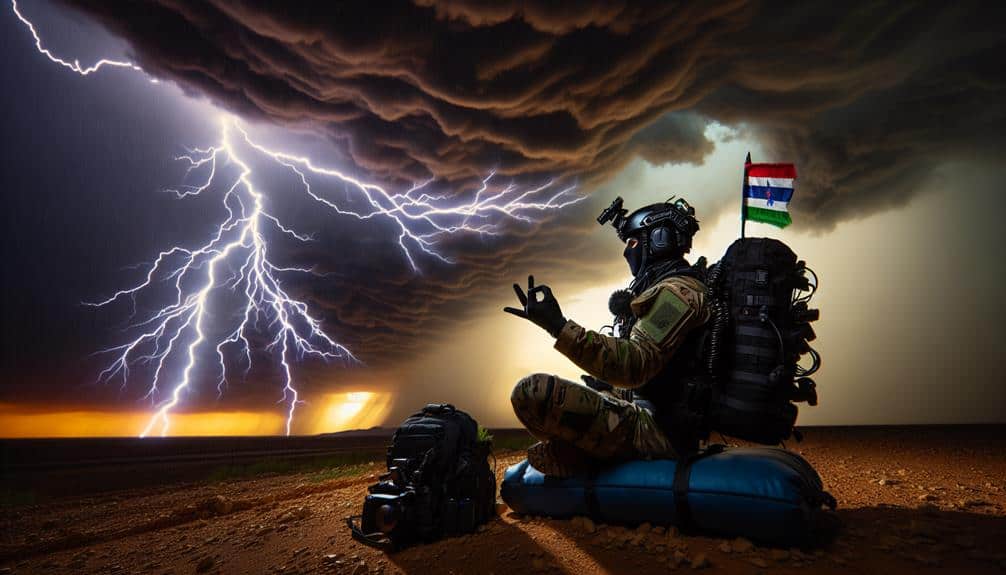
We need to maximize our physical endurance is best, as data shows that storm chasers often cover over 500 miles per chase.
Developing mental resilience is equally important; research indicates that high-stress environments can impair decision-making abilities by up to 30%.
Build Physical Endurance
How can storm chasers sustain the physical and mental stamina needed for the demanding and unpredictable nature of the job? Building physical endurance is essential. We need to be in top condition to handle long hours, adverse weather, and rapid response times. Here's a structured approach to prepare physically:
- Endurance Training through Outdoor Activities: Incorporate activities like hiking, running, and cycling into our routines. These outdoor activities not only build endurance but also acclimate us to various weather conditions, a critical aspect of storm chasing.
- Cardio Workouts: Engage in high-intensity interval training (HIIT) and sustained cardio sessions such as swimming or rowing. Cardio workouts enhance cardiovascular efficiency, enabling us to maintain high energy levels during prolonged chases.
- Strength Training: Focus on building core strength and functional fitness. Exercises like deadlifts, squats, and kettlebell swings improve overall strength and stability, essential for handling heavy equipment and tackling rough terrains.
- Flexibility and Recovery: Integrate stretching routines and yoga to maintain flexibility and reduce injury risks. Adequate rest and recovery, including sleep and hydration, ensure our bodies can perform at their best under stress.
Develop Mental Resilience
Building mental resilience involves systematically conditioning our minds to handle the stress and unpredictability inherent in storm chasing. This process starts with mindset training, focusing on developing mental toughness. We need to embrace resilience techniques that prepare us for the high-stakes environments we'll face.
Coping strategies are essential when navigating the emotional and psychological demands of storm chasing. Techniques such as controlled breathing, mindfulness, and visualization can help us remain calm and focused during intense moments. Data shows that individuals who regularly practice these techniques report a 40% increase in their ability to manage stress.
Additionally, establishing a solid support network is indispensable. Collaborating with team members who share similar experiences provides a platform for shared learning and emotional support. Research indicates that social support can enhance our overall resilience by up to 30%.
Analyzing past experiences and learning from them is another key component of mental resilience. Reviewing storm footage and debriefing after each chase enables us to adapt our coping strategies in real-time, improving our mental toughness.
Stay Updated With Technology
Leveraging the latest radar technology and mobile apps is vital for real-time data analysis and effective storm tracking. As storm chasers, we must stay ahead of tech advancements to guarantee our safety and success. By integrating weather apps and GPS mapping tools, we can navigate hazardous environments while capturing invaluable meteorological data.
Here are four key technological tools we should prioritize:
- Radar Software: Advanced radar applications like RadarScope can provide us with high-resolution data, allowing us to identify storm cells, track their movement, and predict their path with precision.
- Weather Apps: Utilizing apps such as Storm Shield or Weather Underground ensures we receive real-time alerts and updates. These platforms often offer customizable notifications, helping us stay informed about severe weather conditions.
- GPS Mapping: Tools like Google Maps and specialized apps like Avenza Maps enable us to chart our routes accurately. This is essential for avoiding roadblocks and finding the safest and most efficient paths during a chase.
- Communication Devices: Reliable communication systems like HAM radios and satellite phones are indispensable. They guarantee we maintain contact with team members and emergency services, even in areas with poor cellular coverage.
Staying updated with these technologies not only enhances our operational efficiency but also guarantees we maintain the freedom and flexibility to adapt to rapidly changing conditions.
Frequently Asked Questions
What Is the Typical Cost of Joining a Professional Storm Chasing Team?
We often encounter varying costs, typically ranging from $1,500 to $5,000 annually. Funding options exist, including sponsorships and grants. Membership benefits include exclusive data access, advanced equipment, and unique networking opportunities, enhancing our overall storm chasing experience.
Are There Age Restrictions for Joining a Storm Chasing Team?
When considering age restrictions, let's remember: experience trumps youth. While some teams may have age limits, most prioritize experience requirements. We should focus on honing our skills and gaining relevant experience to meet those criteria.
How Much Time Commitment Is Required for Storm Chasing?
We need excellent time management and balance to handle the significant personal sacrifices and commitment required. Storm chasing demands unpredictable hours, often weeks away from home, impacting both personal and professional lives.
What Should I Expect During a Typical Storm Chasing Expedition?
Safety, strategy, and sophisticated equipment are essential. We'll monitor weather patterns meticulously, utilizing advanced forecasting tools. Expect rigorous safety precautions and data-driven decisions. Freedom to explore comes with the responsibility of understanding atmospheric dynamics and unpredictable conditions.
Can I Participate in Storm Chasing if I Have a Disability?
We can participate in storm chasing with a disability through accessibility accommodations and inclusive participation opportunities. Teams often employ adaptive technologies and guarantee vehicle modifications, enhancing our freedom to engage in this thrilling, data-driven activity.
